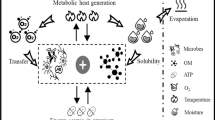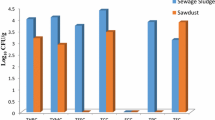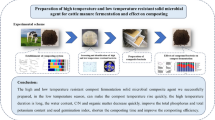Abstract
This study was conducted to evaluate the effect of the sewage sludge treatment method using bio-drying with Ultra-Thermophilic Aerobic Microorganisms (UTAMs). Twelve specific odorous compounds and various sources of bacteria were tested using the sewage sludge treatment method. Sewage sludge was mixed with a seed material and was composted for 47 days. During composting, the temperature was maintained at 80-90oC. The concentrations of the 12 specific odorous compounds after composting did not exceed the allowable exhaust standard for odor. In terms of the bacterial community number after composting, the thermophile bacterial number was 60% of the total bacterial number. The thermophile bacterial ratio after composting increased by 23% compared to the initial composting. The 16S rRNA gene demonstrated that the change in the bacterial community structure was coupled with shifts in the bio-drying process. Therefore, both stable composting operation and economic benefit can be expected when an ultra-thermophilic composting process is applied to sewage sludge.
Similar content being viewed by others
References
Adani, F., Baido, D., Calcaterra, E., and Genevini, P. (2002). “The influence of biomass temperature on biostabilization–biodrying of municipal solid waste.” Bioresour. Technol., Vol. 83, No. 3, pp. 173–179, DOI: 10.1016/S0960-8524(01)00231-0.
Adhikari, B. K., Barrington, S., Martinez, J., and King, S. (2009). “Effectiveness of three bulking agents for food waste composting.” Waste Manage, Vol. 29, No. 1, pp. 197–203, DOI: 10.1016/j.wasman.2008. 04.001.
APHA (American Public Health Association) (2005). Standard methods for the examination of water and wastewater, 21st ed; APHA, Washington D.C., USA.
Colomer, M. F. J., Herrera, P. L., Robles, M. F., Gallardo, I. A., and Pina, G. A. B. (2013). “Effect of airflow on biodrying of gardening wastes in reactor.” Journal of Environmental Sciences, Vol. 25, No. 5, pp. 865–872, DOI: 10.1016/S1001-0742(12)60123-5.
Fraser, B. S. and Lau, A. K. (2013). “The effects of process control strategies on composting rate and odor emission.” Compost Science and Utilization, Vol. 8, No. 4, pp. 274–292, DOI: 10.1080/1065657X. 2000.10702001.
Frei, K. M., Cameron, D., and Stuart, P. R. (2004). “Novel drying process using forced aeration through a porous biomass matrix.” Dry. Technol., Vol. 22, No. 5, pp. 1191–1215, DOI: 10.1081/DRT-120038587.
Fogarty, A. M. and Tuovinen, O. H. (1991). “Microbiological degradation of pesticides in yard waste composting.” Microbiol. Rev., Vol. 55, No. 2, pp. 225–233.
He, P., Zhao, L., Zheng, W., Wu, D., and Shao, L. M. (2013). “Energy balance of a biodrying process for organic wastes of high moisture content: A review.” Dry. Technol., Vol. 31, No. 2, pp. 132–145, DOI: 10.1080/07373937.2012.693143.
Huilinir, C. and Villegas, M. (2015). “Simultaneous effect of initial moisture content and airflow rate on biodrying of sewage sludge.” Water Res., Vol. 82, pp. 118–128, DOI: 10.1016/j.watres.2015.04.046.
Kuok, F., Mimoto, H., and Nakasaki, K. (2012). “Effects of turning on the microbial consortia and the in situ temperature preferences of microorganisms in a laboratory-scale swine manure composting.” Bioresour. Technol., Vol. 116, No. 4, pp. 421–427, DOI: 10.1016/j.biortech.2012.03.106.
Ministry of Environment in Korean (2015). Environmental Statistics Yearbook, https://doi.org/library.me.go.kr/search/DetailView.ax?sid=1&cid=155027.
Navaee-Ardeh, S., Bertrand, F., and Stuart, P. R. (2010). “Key variables analysis of a novel continuous biodrying process for drying mixed sludge.” Bioresour. Technol., Vol. 101, No. 10, pp. 3379–3387, DOI: 10.1016/j.biortech.2009.12.037.
Navaee-Ardeh, S., Bertrand, F., and Stuart, P. (2006). “Emerging biodrying technology for the drying of pulp and paper mixed sludges.” Dry. Technol., Vol. 24, No. 7, pp. 863–878, DOI: 10.1080/07373930600734026.
Poulsen, T. G. and Bester, K. (2010). “Organic micropollutant degradation in sewage sludge during composting under thermophilic conditions.” Environ. Sci. Technol., Vol. 44, No. 13, pp. 5086–5091, DOI: 10.1021/es9038243.
Shen, Y. J., Chen, T. B., Gao, D., Zheng, G. D., Liu, H. T., and Yang, Q. W. (2012). “Online monitoring of volatile organic compound production and emission during sewage sludge composting.” Bioresour. Technol., Vol. 123, No. 4, pp. 463–470, DOI: 10.1016/j.biortech.2012.05.006.
Storey, S., Chualain, D. N., Doyle, O., Clipson, N., and Doyle, E. (2015). “Comparison of bacterial succession in green waste composts amended with inorganic fertilizer and wastewater treatment plant sludge.” Bioresour. Technol., Vol. 179, pp. 71–77, DOI: 10.1016/j.biortech.2014.11.107.
Takahiro, Y., Toshiyuki, M., and Tairo, O. (2013). “Bacterial and biochemical properties of newly invented aerobic, High-Temperature compost.” In book: Thermophilic Microbes in Environmental and Industrial Biotechnology, Springer, Dordrecht, Netherland, pp. 119–135, DOI: 10.1007/978-94-007-5899-5_4.
Tambone, F., Scaglia, B., Scotti, S., and Adani, F. (2011). “Effects of biodrying process on municipal solid waste properties.” Bioresour. Technol., Vol. 102, No. 16, pp. 7443–7450, DOI: 10.1016/j.biortech.2011.05.010.
Tchobanoglous, G., Burton, F. L., and Stenser, H. D. (2004). Wastewater engineering: Treatment and reuse, McGrow-Hill Publishing, New York, USA.
Velis, C., Longhurst, P., Drew, G. H., Smith, R., and Pollard, S. J. T. (2009). “Biodrying for mechanical–biological treatment of wastes: A review of process science and engineering.” Bioresour. Technol., Vol. 100, No. 11, pp. 2747–2761, DOI: 10.1016/j.biortech.2008.12.026.
Yamada, Y. and Kawase, Y. (2006). “Aerobic composting of waste activated sludge: Kinetic analysis for microbiological reaction and oxygen consumption.” Waste Manage, Vol. 26, No. 1, pp. 49–61, DOI: 10.1016/j.wasman.2005.03.012.
Zhao, L., Gu, W. M., He, P. J., and Shao, L. M. (2010). “Effect of airflow rate and turning frequency on bio-drying of dewatered sludge.” Water Res., Vol. 44, No. 20, pp. 6144–6152, DOI: 10.1016/j.watres.2010.07.002.
Zhao, L., Wang, X. Y., Gu, W. M., Shao, L. M., and He, P. J. (2011). “Distribution of C and N in soluble fractionations for characterizing the respective biodegradation of sludge and bulking agents.” Bioresour. Technol., Vol. 102, No. 22, pp. 10745–10749, DOI: 10.1016/j.biortech.2011.08.111.
Zhang, D. Q., He, P. J., Jin, T. F., and Shao, L. M. (2008). “Bio-drying of municipal solid waste with high water content by aeration procedures regulation and inoculation.” Bioresour. Technol., Vol. 99, No. 18, pp. 8796–8802, DOI: 10.1016/j.biortech.2008.04.046.
Zhang, J., Gao, D., Chen, T. B., Zheng, G. D., Chen, J., Ma, C., Guo, S. L., and Du, W. (2010). “Simulation of substrate degradation in composting of sewage sludge.” Waste Manage, Vol. 30, No. 10, pp. 1931–1938, DOI: 10.1016/j.wasman.2010.04.004.
Author information
Authors and Affiliations
Corresponding author
Rights and permissions
About this article
Cite this article
Park, S., Song, H. & Kim, M. Performance and Bacterial Communities for Bio-drying with Thermophili Bacteria of Sewage Sludge. KSCE J Civ Eng 22, 4806–4813 (2018). https://doi.org/10.1007/s12205-017-2298-7
Received:
Accepted:
Published:
Issue Date:
DOI: https://doi.org/10.1007/s12205-017-2298-7




